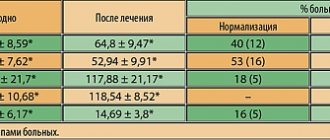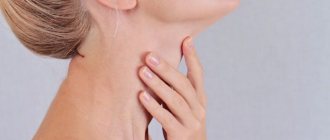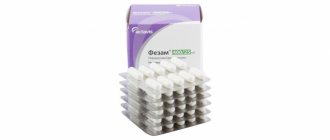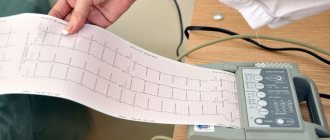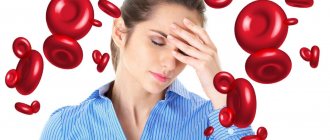Ascorutin belongs to the group of vitamin-containing drugs. The medicine is widely used for various diseases accompanied by decreased immunity, fragility of blood vessels and capillaries, allergies, lack of vitamins C and P, and other conditions. Instructions for use of Ascorutin include indications such as prevention of hypovitaminosis P and C, vascular pathologies, elimination of flu symptoms and others. The product is available in the form of tablets, each of which contains 50 mg of rutin and ascorbic acid.
Analogs
Instead of Ascorutin, you can use analogues containing the same active substances:
- Ascorutin D or Ascorutin-UBF. These drugs have the same composition and the same indications for use as Ascorutin.
- Prophylactic S. In this preparation, the dosage of ascorbic acid is higher (100 mg), and rutoside, on the contrary, is reduced (25 mg). The medicine is prescribed to prevent or eliminate the deficiency of its constituent compounds, as well as for children over 4 years of age with heavy loads or intensive growth. The drug is in demand for the prevention of acute respiratory infections, as well as for their complex treatment.
- AscoRutical forte. These film-coated tablets contain not only rutoside at a dose of 50 mg and vitamin C at a higher dose (200 mg), but also 200 mg of calcium. The remedy is indicated for a- or hypovitaminosis, infectious diseases, as well as problems with blood vessels. It can be given from 5 years of age.
What childhood diseases are treated with ascorutin?
Ascorutin is very effective in fighting infections. The poor condition of the vascular system greatly aggravates the course of diseases such as influenza, scarlet fever, tonsillitis and measles. The drug serves to strengthen the walls of blood vessels, eliminates their fragility, and improves permeability. It relieves skin rashes that often accompany infectious diseases.
With the help of ascorutin, it is possible to prevent and alleviate the course of childhood chronic glomerulonephritis. These diseases are expressed in the impact of infection on the kidneys, further tissue inflammation, swelling and loss of organ functionality. Glomerulonephritis is accompanied by accelerated loss of proteins, which entails weakening of the child’s body. Ascorutin takes an active part in returning the renal tubules and glomeruli to their functionality. During the treatment of glomerulonephritis in children over 3 years of age, the drug is often included in a complex of health procedures.
Ascorutin helps to effectively treat children suffering from hemorrhagic diathesis
Increased bleeding can be caused by capillary toxicosis (Henoch-Schönlein disease). Children aged 5–10 years are often susceptible to this disease. The pathology develops in the process of joining an allergic reaction to the vascular tissues to the infection. Due to excessive capillary permeability, the skin becomes covered with a characteristic rash. Hemorrhagic diathesis is also expressed by thrombocytopenic purpura (Werlhof's disease), in which blood clotting is impaired as a result of platelet deficiency. Ascorutin, which is involved in the complex treatment of hemorrhagic diathesis, strengthens blood vessels and reduces the activity of the enzyme hyaluronidase, which destroys intercellular tissue.
Ascorutin is used to treat nosebleeds in children.
Effect of the drug
Ascorutin refers to capillary-stabilizing (capillary-protective) drugs containing in one tablet of a greenish or yellowish tint:
- ascorbic acid (vitamin C) – 50 mg;
- rutin (rutoside) – 50 mg.
In addition to vitamins, tablets are made with additional ingredients: sugar, potato starch, calcium stearate, talc.
Ascorutin is produced by many pharmaceutical companies in the former Soviet Union in tablet form
The beneficial properties of a drug are determined by its active components.
Ascorbic acid (vitamin C) is vital for human health, but is not produced by the body, but enters it with plant foods.
Vitamin C:
- prevents fragility and fragility of blood vessels, strengthens them and makes them more elastic;
- is a participant in hematopoiesis. Promotes normal absorption of iron;
- exhibits antioxidant properties;
- improves the condition of the immune system, which prevents the emergence and development of bacteria, viruses, and various infections. Is indispensable for colds and fever;
- participates in the metabolic process;
- helps increase skin turgor at the cellular level by participating in collagen production;
- has a beneficial effect on the nervous system;
- removes cholesterol from the body;
- has an anti-inflammatory effect;
- has a regenerating effect, promotes rapid healing of skin damage, etc.
A lack of vitamin C in the body is fraught with:
- a decrease in the body’s defenses and, as a result, colds and viral diseases;
- increased fatigue, irritability, lethargy, fatigue, depression;
- scurvy;
- bleeding from the gums;
- deterioration of the condition of the skin, hair, and cartilage tissue;
- premature aging, etc.
Vitamin P is also not produced by the body, but is found in foods of plant origin. Rutin is a natural compound that combines a group of flavonoids.
Vitamin P:
- helps better absorption of ascorbic acid, participates in the production of vitamin E;
- normalizes metabolism;
- thins the blood;
- increases the elasticity and strength of blood vessels;
- helps normalize blood pressure;
- has a regenerating effect;
- participates in the production of collagen, which leads to a rejuvenating effect;
- prevents varicose veins, spontaneous bleeding, and the appearance of cellulite;
- participates in the formation of bile and the regulation of daily urination;
- has an anti-edematous and analgesic effect;
- fights allergies;
- acts as an antioxidant defense for the body from external negative factors;
- Boosts immunity and more.
Lack of routine manifests itself:
- fragility of capillaries in the form of: subcutaneous pinpoint hemorrhages, small bruises;
- pain in the lower extremities;
- general weakness, malaise, fatigue, decreased performance.
These symptoms are most often observed in the autumn-winter period, in the absence of fresh vegetables, fruits and berries in the diet.
Ascorutin has a pronounced strengthening effect on the smallest vessels - capillaries
Ascorutin is prescribed:
- in case of deficiency of ascorbic acid and vitamin P in the body;
- capillary pathologies caused by the use of medications containing salicylic acid and drugs that lead to a decrease in blood clotting (indirect coagulants);
- hemorrhagic diathesis – pathologies accompanied by bleeding and hemorrhage. The effect of the drug manifests itself mainly in cases of impaired capillary permeability (capillary toxicosis or Henoch-Schönlein disease), as well as a decrease in platelets in the blood (thrombocytopenic purpura);
- hemorrhage into the tissue of the eyes;
- radiation sickness, accompanied by damage to the vascular walls;
- infectious and infectious-allergic heart diseases (septic endocarditis, rheumatism);
- glomerulonephritis;
- arachnoiditis;
- allergies;
- infectious diseases that cause damage to capillaries (measles, scarlet fever, typhus, influenza);
- hypertension.
The drug is also able to eliminate nosebleeds caused by fragility of blood vessels.
Instructions for use and dosage
The drug is taken after meals, swallowing the tablet and washing it down with water. When chewing or resorption of Ascorutin, the ascorbic acid included in its composition will negatively affect tooth enamel. The water with which you need to drink the drug should not be mineral, so that its alkalis do not neutralize vitamin C.
The therapeutic single dosage of Ascorutin in childhood is one tablet of medication. It should be drunk three times a day. The duration of therapy should be determined by the doctor, but often ranges from 10 days to three weeks. If a child develops any symptoms of a side effect of Ascorutin, the medicine is immediately discontinued.
To prevent ARVI, children can be given half to a whole tablet of Ascorutin daily. The dose is selected depending on age, for example, at 4-5 years old only half a tablet is given, and at 8 years old - a whole tablet. The drug is taken for prophylactic purposes once a day for 7-10 days.
What is Ascorutin used for, indications for use
The drug helps and is prescribed in the following cases:
- 1. For heavy periods
- 2. For facial skin
- 3. For age spots for adults
- 4. Cuperosis
- 5. For hemorrhoids
- 6. For varicose veins
- 7. To strengthen the walls of blood vessels
- 8. For nosebleeds
- 9. For uterine bleeding
- 10. For acne
- 11. For influenza and ARVI
- 12. Before childbirth
- 13. For varicose veins
- 14. For prevention
- 15. When planning a pregnancy
Harm or benefit, what is useful, how to use and side effects we will consider below.
Compound
The product contains the active ingredient - ascorutic acid - 50 mg. MNN and rutin 50 mg, auxiliary components - sugar, calcium stearate alone, starch. Release form: yellow-green tablets with inclusions. The effect of ascorbic acid on the body is positive, it thickens the blood. Regulates redox balance, case. Prevention for vascular walls. Vitamin.
Analogs
The drug has a number of cheaper substitutes and analogues.
- 1. Vikasol
- 2. Troxeturine
- 3. Detralex
- 4. Aevit
They belong to the same pharmacological group. Indicated for children and adults in case of vitamin deficiency.
Main indications for taking Ascorutin
The drug is prescribed to prevent the development and treatment of pathologies accompanied by insufficient blood circulation, blood disorders or vitamin deficiency. Among them:
- tendency to increased platelet formation;
- vascular damage by salicylates;
- hemorrhagic diathesis;
- hemorrhage in the retina;
- violation of intraocular pressure;
- atherosclerotic changes;
- rheumatism;
- Iron-deficiency anemia;
- some forms of hypertension;
- venous insufficiency;
- varicose veins: lower extremities, rectum;
- trophic ulcerative lesions;
- thrombophlebitis;
- consequences of severe scarlet fever, measles;
- frequent nosebleeds;
- changes in blood composition as a result of radiation exposure.
In most cases, Ascorutin is indicated in combination with other medications or vitamin-mineral medications.
As an adjuvant, Ascorutin is used in vitamin therapy for menstrual disorders: for heavy or irregular discharge. Its regular use helps to normalize pancreatic function and the absorption of glucose by cells. This helps stabilize the condition of diabetic patients at an early stage.
For diseases of the joints and spine, the product improves metabolic processes in the tissues of cartilage and skeleton, prevents the leaching of calcium, supports the formation of intra-articular lubrication, and slows down inflammatory reactions.
Instructions for use
The instructions for use indicate that before starting treatment, you must consult a doctor who will tell you how to take Ascorutin for different conditions and depending on age.
- The tablets need to be swallowed after meals, the dose for adults is 1-2 units per day for prevention, for therapeutic purposes, 2 pieces are prescribed three times a day. The average course duration is 3-4 weeks. If necessary, treatment can be continued after a month's break.
- The dosage of Ascorutin and the method of use in childhood is to use half a tablet once every 24 hours to prevent the development of diseases and deficiency conditions. Children over 3 years of age are prescribed one piece for therapy 2-3 times a day.
Constant monitoring and control of the functioning of all systems is required. It is not recommended to drink liquids with alkaline content, as the absorption of the composition is reduced.
Method of administration and dose
How to take Ascorutin? Each package of the drug contains an insert - instructions for use. In the instructions you can read in detail about the features of using the drug for various diseases. Despite this, you should still not self-medicate. Before using the medicine, it is recommended to undergo examination in a hospital and consult a doctor. A specialist will help you choose the optimal dose and method of application.
Adults
For prevention, adult patients are recommended to take 1 or 2 tablets of Ascorutin throughout the day. During the treatment of various pathologies, patients are usually prescribed 1-2 tablets three times a day.
Is it better to swallow the drug or dissolve it? The product must be swallowed with a sufficient amount of water. The dose may be increased at the discretion of the doctor. The duration of therapy is selected individually depending on the patient’s condition.
For varicose veins in the legs and hemorrhoids, it is recommended to include creams and ointments that have a venotonic effect in the complex therapy of patients. For example, Troxevasin and others.
Children
The use of Ascorutin among children over 4 years of age is permitted. The recommended dose for prevention is 0.5 - 1 tablet per day. For therapeutic purposes, 0.5 - 1 tablet is prescribed three times a day. The course usually lasts 3–4 weeks, the exact duration is determined by the leading pediatrician. If the baby has not learned to swallow tablets and wash them down with water, you can grind the product into powder, mix it with a small amount of liquid, and give it to the child.
Ascorutin is prescribed in the same dosage as for adults to strengthen the immune system, as well as treat various diseases in adolescence.
The drug is prescribed to children from 4 years of age
Pregnant
Why is the medicine used during pregnancy? It is worth noting that the product cannot be used in the first trimester of pregnancy. It is prohibited to take the drug in combination with other vitamin complexes. Starting from the 2nd and 3rd trimester, the doctor prescribes the medicine 1 tablet three times a day.
Important! Independent use of Ascorutin during a delicate period can cause significant harm not only to the mother’s body, but also to the child.
Interaction with other drugs
- If you prescribe Ascorutin along with iron supplements, Fe absorption will improve.
- The combined use of Ascorutin and penicillin antibiotics also leads to greater absorption of the antibacterial agent.
- Ascorutin has the ability to reduce the therapeutic effect of anticoagulants (both indirect and heparin).
- Sulfonamide drugs prescribed together with Ascorutin will be less effective.
- If you give your child Ascorutin and salicylates together, their side effects will increase.
- Prescribing Ascorutin together with B vitamins will enhance their therapeutic effect.
- With long-term use of Ascorutin, it is possible to enhance the effect of non-steroidal anti-inflammatory drugs, antihypertensive drugs and cardiac glycosides.
Drug overdose
With uncontrolled use of the medication, an overdose can quite easily occur. As a rule, this happens if the patient takes 10 or more tablets at a time.
In such situations, a person may experience the following symptoms:
- a sharp increase in blood pressure;
- disruption of the pancreas;
- renal dysfunction.
Also, after taking a large number of pills, the patient often experiences headaches, vomiting, insomnia, diarrhea and nausea. In case of an intentional or accidental overdose of Ascorutin, the victim is recommended to drink 6-7 tablets of activated carbon, and then immediately call an ambulance.
Side effects
In most cases, the vitamin preparation is well tolerated by patients. With the correct dosage and compliance with all doctor’s recommendations for taking the drug, no negative effects are observed. If any alarming symptoms occur, such as headache, allergies, insomnia, digestive upset, etc., you should stop taking the medication.
Sometimes side effects occur in the form of skin allergies
When taking more than 10 tablets at one time, there is a high risk of overdose. In this case, a person experiences pain in the stomach and intestines, headache, vomiting, sleep disturbances, and loss of appetite. To alleviate the condition, you need to drink 6 tablets of activated carbon. This will help remove excess rutin and vitamin C from the blood.
Use during pregnancy and lactation
Whether this drug can be used by a woman expecting a child depends on the period at which she is pregnant. Ascorutin during pregnancy is strictly contraindicated in the first trimester, which is explained by the following. During the period when all the organs of the fetus are being formed, the penetration of any third-party substances through the blood of a pregnant woman to the baby should be limited as much as possible, so as not to harm him.
When a woman is in later stages of pregnancy, Ascorutin can be prescribed, for example, for dilated veins in the legs or for the prevention of uterine bleeding during labor. Whether this medicine can be taken during lactation should also be decided by the doctor. Although rutin does not pass into breast milk, and vitamin C is detected there in insignificant concentrations, a breastfed baby is very sensitive to any change in the composition of its diet. For this reason, doctor's supervision when taking the drug is mandatory.
special instructions
The absorption of ascorbic acid worsens when Ascorutin is consumed simultaneously with fresh sour juices. In addition, vitamin absorption is reduced in diseases of the digestive system.
Taking the drug enhances the absorption of iron, so it is prescribed with caution to patients with hemochromatosis, thalassemia, leukemia and some other conditions.
When prescribing Ascorutin, the doctor must take into account special instructions
During long-term treatment with Ascorutin, it is important to monitor the condition of the kidneys and regularly measure blood pressure.
The daily dose of the drug should not exceed 1 g per day.
Since ascorbic acid has a mild stimulating effect, it is recommended to take the medicine in the morning.
Pharmacological effect
What are the benefits of Ascorutin? A combined vitamin-containing product helps solve many problems with various diseases. Ascorutin is prescribed to enhance redox processes, to establish carbohydrate metabolism, and the synthesis of natural steroid hormones. The drug also takes an active part in the restoration and synthesis of connective tissue in the body.
In addition, the medicine weakens the effects of radiation, promotes the elimination of waste and toxins, which is important during the recovery period from influenza, acute respiratory viral infections and other diseases. Indications for the use of the drug Ascorutin include conditions in patients with acute venous insufficiency, accompanied by pain, swelling, and vascular inflammation
Scope of use of the medicine
What are the indications for the use of Ascorutin? The drug is prescribed to patients for the following purposes:
- restoration of the integrity of capillaries damaged during treatment with salicylates and anticoagulants;
- elimination of residual symptoms of influenza and acute respiratory viral infections;
- prevention of colds and viral diseases;
- treatment of diseases associated with impaired vascular permeability. These include allergies, hemorrhagic diathesis, septic endocarditis, radiation sickness;
- therapy for deficiency of vitamin complexes.
The medicine Ascorutin is prescribed for varicose veins
When considering the question of what Ascorutin helps with, it is important to mention that the drug is used to prevent hypovitaminosis and vitamin deficiency C and P. Doctors often recommend using the medicine in the cold season to maintain the body’s immune defense at the proper level and prevent colds.
How is ascorutin taken?
You can also read: Contraindications for the use of Ascorutin
The drug is available in the form of tablets interspersed with capsules containing syrup, which improves the taste of the drug. Before taking ascorutin, you should understand that vitamins are not analogues of sweets and their overdose can adversely affect the child’s body.
The following dosages are established for the use of the drug:
- When implementing preventive measures, children aged 3–12 years are given half or a whole tablet once a day. If the remedy is part of a treatment complex for any disease, the procedure becomes three times more frequent.
- After reaching 12 years of age, for preventive purposes, a child should take 1–2 tablets per day; during treatment, the same dose is used, but 3 times a day.
Ascorutin is taken orally after meals and washed down with plain water. When taking the medicine, it is not recommended to drink juice or mineral water at the same time. They slow down the absorption of the drug.
The course of treatment with ascorutin lasts about three weeks. This period may be extended by the decision of the attending physician.
Instructions for use and dosage
The drug must be taken after meals, washing down the tablet with a sufficient amount of water. Chewing Ascorutin causes destruction of tooth enamel, as indicated by the instructions for use of the drug.
A single dose of the drug for children aged 3 to 12 years is 0.5 - 1 tablet per day for the purpose of prevention and 3 tablets in the case of complex treatment of any disease.
For children over 12 years of age and adults, the dosage of the drug for prevention is 2 tablets per day, and for treatment, 2 tablets three times a day.
Overdose
A large number of Ascorutin tablets, when taken simultaneously, causes headache, diarrhea, nausea, vomiting and insomnia.
To quickly get rid of such symptoms, you must immediately take activated charcoal and call an emergency ambulance.
Attention! Ascorutin is strictly not recommended for use by children under one year of age. Side effects
Side effects
- Disturbances in the functioning of the intestinal-digestive system.
- Skin allergic manifestations.
- Nausea or vomiting.
- Migraines or headaches.
- Insomnia.
- Increased blood pressure.
- Heat.
These reactions do not occur very often and are caused by an overdose of the drug, its uncontrolled use for a long time, hypersensitivity to components, high blood clotting rates and diabetes, so it is not recommended to prescribe it to people with such pathologies.
Attention! Taking Ascorutin, even in recommended doses, affects the results of blood sugar tests. Contraindications
Contraindications
- Individual intolerance to vitamins P and C.
- Children under three years of age.
- Increased blood clotting.
- Pregnancy until the third trimester.
- Urolithiasis disease.
- Diabetes.
- Thrombophlebitis.
- Gout.
Interaction with other drugs
- The absorption of iron supplements improves.
- The combined use of Ascorutin and penicillin leads to greater absorption of the antibacterial agent.
- Ascorutin reduces the therapeutic effect of anticoagulants.
- Sulfanilamide agents used together with Ascorutin are less effective.
- The effect of adverse reactions to salicylates in children increases with the use of Ascorutin.
- Rutin enhances the therapeutic effect of vitamin B.
- Long-term use of Ascorutin enhances the effect of non-steroidal anti-inflammatory drugs, antihypertensive drugs and cardiac glycosides.
Release form and price
The drug is produced in the form of tablets, in packs of 10, 50 and 100 pieces.
The tablets are flat-cylindrical in shape, have a yellow-greenish color, with the presence of small inclusions.
This medicine is not produced in the form of syrup, capsules or solution.
The drug is sold in pharmacies without a doctor's prescription.
The average cost of one package of 50 tablets is 40 – 60 rubles.
Side effects
Sometimes the drug can affect:
- Central nervous system. Long-term use of the drug is fraught with headaches, increased fatigue, tiredness, drowsiness during the day and insomnia at night. These undesirable manifestations are caused by ascorbic acid, they disappear after discontinuation of the drug.
- Gastrointestinal tract. The presence of vitamin C in tablets has an irritating effect on the inner layer of the stomach, which leads to spasms of the smooth muscles of the organ and, as a result, nausea, vomiting, pain, and heartburn. Diarrhea is possible.
- Endocrine system and metabolism. The diabetogenic effect inherent in vitamin C makes it undesirable to use the medicine if there is a lack of insulin. In some cases, it is possible to use Ascorutin in a minimal dosage with constant monitoring of glucose levels in the diabetic’s body. By causing disruptions in salt metabolism, the drug can lead to the formation of oxalate stones in the urinary system. In addition, it is also undesirable for gout. Tumors of a malignant nature, which are characterized by rapid growth, or metastases begin to progress faster when consuming Ascorutin due to the effect of vitamin C on their cellular metabolism.
- Cardiovascular system. Taking the drug in large quantities can cause arterial hypertension. With blood clots in the vessels, they may break off with subsequent adverse consequences.
Side effects of Ascorutin are very rare
The use of Ascorutin can lead to allergic reactions manifested by skin rash, urticaria (itchy blisters), Quincke's edema (causing swelling of the larynx, pharynx, trachea), as well as anaphylactic shock.
Composition and properties
According to the instructions for use, “Ascorutin” is produced in the form of tablets for oral administration. The tablets are yellowish-green in color with small inclusions. One package can contain 30 or 50 tablets. The drug contains the following active ingredients:
- Vitamin C.
- Rutin (vitamin P).
Auxiliary components of the drug are calcium stearate, talc, potato starch, sugar.
The combination of two vitamins makes the scope of Ascorutin quite wide. It is often prescribed as part of complex therapy for the treatment of various pathologies. The goal of such therapy is to increase the intensity of redox processes, improve carbohydrate metabolism, and stimulate the production of natural steroid hormones. In addition, the vitamins contained in the medication take an active part in the regeneration of connective tissues in the body.
As the instructions for use indicate, “Ascorutin” is also used for children.
The drug reduces the effects of radiation and also accelerates the process of eliminating toxins and waste, which is important during the recovery period after suffering from influenza, acute respiratory infections and other viral diseases.
How does Ascorutin work?
The vitamins contained in the drug quickly dissolve in the stomach and are absorbed through the mucous membrane into the blood. In the complex, ascorbic acid and rutoside complement and enhance each other’s effectiveness. Both compounds are active antioxidants. They help reduce intoxication of the body during inflammatory and infectious processes, increase resistance, regulate blood clotting and fluidity, preventing red blood cells from sticking together.
In the complex therapy of vascular diseases, Ascorutin helps restore peripheral blood supply, restore the integrity of capillaries, prevent and eliminate edema, trophic ulcers, improve the supply of nutrients to tissues and the removal of toxins.
Analogs of vitamin preparation
Ascorutin tablets are produced by many Russian pharmaceutical companies. Medicines with the same composition are not produced abroad. The domestic drugs Ascorutin-UBF and Ascorutin-D are considered complete structural analogues of the active ingredients. The difference between the second remedy is the absence of sucrose.
Ascorutin-D tablets can be taken by patients with diabetes. Many domestic and foreign medicines contain one of the active ingredients - ascorbic acid or rutin. Partial analogues are Rutin, Ascovit, Vitamin C, Venoruton. If you need a substitute, you should consult a doctor, since not all analogues of Ascorutin can be used in childhood.
Tags: Ascorutin, medications, medications for children, medications for pregnant women, medications during pregnancy, medications, medications, drug Ascorutin, use of Ascorutin
Storage conditions and terms
The medicine does not require special storage conditions. It is enough to place the packaging away from ultraviolet rays, where it will be inaccessible to small children.
Temperature range: from +15 to +25 degrees. You should not put the tablets in the refrigerator. The shelf life of the pharmacological product is three years, starting from the date of release. Taking expired medications is not allowed.
It must be remembered that any drugs, even very harmless ones at first glance, cannot be prescribed independently. A specialist will develop a regimen for the treatment or prevention of nosebleeds in children or adolescents.
Contraindications and side effects
Despite the fact that Ascorutin is a regular vitamin, the drug has contraindications. First of all, this is individual sensitivity to the components that make up it.
The drug is prescribed with caution in cases of increased blood viscosity and a tendency to form blood clots.
Ascorutin is not recommended for people with chronic diseases of the urinary system, including urolithiasis and renal failure. The drug is prohibited for patients with impaired potassium-magnesium homeostasis. Diabetics should be careful when choosing a product, giving preference to drugs without sugar.
Taking the drug may be accompanied by symptoms such as:
- nausea;
- dizziness;
- allergic reactions;
- loose stools;
- vomit.
If the side effects are pronounced, it is better to stop taking the drug.
Overdose
Exceeding the therapeutic dose of ascorbic acid can cause an increase in the concentration of oxalic acid in the urine, crystallization of citrates and urates. The consequence is diarrhea or urolithiasis.
Contraindications Ascorutin
To achieve the best therapeutic effect with the drug, it is necessary to select the correct dosage of the drug and take into account all possible contraindications to its use. Treatment with Ascorutin is prohibited for patients with the following conditions:
- imbalance of potassium and calcium in the body;
- diabetes;
- kidney pathologies, urolithiasis, renal failure;
- intolerance to the components of the product;
- first trimester of pregnancy;
- age about 4 years.
The use of the medicine leads to a rapid increase in blood glucose, which is unacceptable for people with diabetes. It is not advisable to use the product if there is increased blood clotting.
Neglecting contraindications can lead to the development of a severe allergic reaction and dangerous consequences for the patient’s health.
Ascorutin instructions for use of tablets for adults
Ascorutin is able to increase the strength of connective tissue, reduce the permeability of capillaries and blood vessels, relieve swelling and regulate processes in the body, increasing resistance to adverse environmental factors and infectious diseases thanks to rutoside and rutin. The body's reaction time is instantaneous. Great for autumn and spring.
When the body weakens and resistance to pathogenic bacteria decreases. It can be prescribed as an additional therapy for the treatment of various diseases, including oncology or HIV. For adults, the dosage is approximately 1-2 tablets, for children under 12 years old - half a tablet 2 times a day. The course must be determined individually, it is advisable to consult a doctor. The regimen for taking pills depends primarily on the disease or as a preventive measure.
How to take during pregnancy?
This is the most controversial drug during pregnancy and lactation, breastfeeding. Some doctors prohibit it for pregnant women, while others, on the contrary, recommend it. However, all this is individual and is used under the supervision of doctors. Typically the daily dose is 60-80 mg. swallow while eating.
For children dosage
Ascorutin is prescribed to children over 3 years of age. To treat the disease, 2 tablets are prescribed 2 times a day. For prevention, the dose is 1 tablet per day for kidney or blood diseases.
During menstruation
During menstruation, a woman is recommended to take a dosage of 80 mg. in one go.
For hemorrhoids
If there are hemorrhoids, doctors advise using ascorutic acid in a course. Depending on the degree of the disease, you should take 2 tablets 2 times a day.
Should I suck or drink Ascorutin?
Many customers in pharmacies have a question: “Do you dissolve or drink the drug?”
It is correct to drink ascorutin with water after meals. Under no circumstances should you drink it with juice or mineral water, as this can stop the proper absorption of the drug by the intestines.
For nosebleeds
For nosebleeds, as well as any other types of bleeding, it is necessary to increase the usual dose of the drug to 80 mg at a time, possibly with chamomile. If the frequency increases, you should consult a doctor.
Reviews
Lidiya Vasilievna, general practitioner, Moscow I prescribe Ascorutin depending on the patient’s health condition. If no pathologies are identified, but the person is systematically susceptible to colds and viral diseases, he feels a constant feeling of weakness. This is a direct indication for prescribing the drug. It has proven itself well, is suitable for almost all categories of patients, when used correctly, causes virtually no side effects and is affordable.
Igor, 38 years old, builder, Belgorod With the beginning of autumn I start to get sick. Working outdoors, I constantly catch colds. It is undesirable to take sick leave due to a severe loss in wages. Mom suggested taking Ascorutin. At first nothing, but after a week small blisters appeared that were very itchy. He did not in any way connect their occurrence with taking the medicine, and began to get rid of the rash with all kinds of ointments. As a result, I had to see a doctor. It turned out that these manifestations are one of the side effects of the drug. As soon as I stopped taking Ascorutin, the rashes disappeared.
Svetlana, 32 years old, housewife, Perm We have two children in our family – 5 and 8 years old. The older one has constant nosebleeds even when the weather changes, not just from blows. I started taking Ascorutin tablets twice a day. After a week the bleeding became less. And after the course of treatment (a month) they disappeared completely. In addition, I give my kids pills in the fall to prevent colds and flu. The children practically do not get sick, are active, and do well at school. There are no side effects. I am very grateful to the drug. I am a supporter of healthy eating and in the summer I try not to feed the children pills, but provide them with a healthy diet.
Elena, 25 years old, young mother, Pskov The pregnancy was very difficult: swelling, varicose veins, symptoms of hemorrhoids, constant threat of failure. She took a huge amount of medications. In the middle of pregnancy, the gynecologist prescribed Ascorutin. At first I was skeptical. But over time, the drug was appreciated. The unpleasant symptoms gradually decreased, the birth went well, and the baby was born healthy.
Description of the drug
Ascorutin belongs to the pharmacological group of drugs with a combined effect. The tablets are sweet and sour in taste, light green in color, beveled and scored. They have a flat-cylindrical shape. Cardboard packaging may contain 10, 50 or 100 tablets. When packaged in PVC or glass bottles - 30 or 50 pieces. The pharmacological agent is approved for over-the-counter release.
https://youtube.com/watch?v=3ivjX1rsSeg
The drug compensates for the deficiency of ascorbic acid and rutin. It is known that vitamins P and C increase resistance to infections, as well as harmful environmental factors. Their combination strengthens connective tissues and promotes cell regeneration. Prescribed for conditions characterized by increased permeability of the vascular wall and capillary fragility.
Rutin is absorbed in the digestive tract, facilitating the transport of ascorbic acid to the small intestine. It is excreted from the body within a maximum of 24 hours with bile or urine. Ascorbic acid in the body is converted to dehydroascorbic acid, after which it is distributed throughout the body. Most goes to the adrenal glands, where the substance is metabolized and then eliminated through the urinary system in the form of oxalate. The remaining part is excreted with bile through the digestive tract.
Drug interactions
When prescribing the drug, its compatibility with other medications should be taken into account:
- Ascorutin reduces the therapeutic effect of Heparin, Biseptol;
- the vitamin complex enhances the negative effect of salicylates on the body;
- the combination of oral contraceptives is reduced by the influence of ascorbic acid;
- when treating with cardiological drugs, a break is needed during therapy with Ascorutin;
- Vitamins P and C enhance the effect of nicotinic acid.
Considering this list, you should definitely listen to the opinion of doctors regarding taking Ascorutin. The combination of even harmless drugs can provoke serious consequences for the body.
Analogue of ascorutin for adults
One of the most effective analogues of ascorutin for adults is Detralex. The drug treats venous insufficiency, acute and chronic hemorrhoids. The product allows you to get rid of cramps and relieve pain in the lower extremities. It relieves swelling, accelerates the treatment of trophic disorders and varicose ulcers. Since Detralex does not pose a threat to the developing fetus, the drug can be prescribed to women during pregnancy. Its use is not recommended during lactation. In any case, Detralex should be taken only after consultation with a specialist.
Detralex - ascorutin for adults
Considering the numerous reviews about ascorutin, we can conclude that taking this drug is indeed very effective. Thanks to it, colds in children are reduced by 2-3 times, and there is also a noticeable effect on improving the health of children experiencing chronic bleeding. The unsatisfactory effect of the product is associated solely with neglect of the instructions for its use and the lack of prior consultation with a pediatrician.
